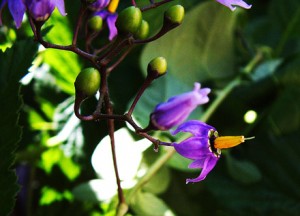 Classification: Hallucinogenic deliriant
Classification: Hallucinogenic deliriant
Common Names/Nicknames: Belladonna, devil’s berries, nightshade, Jimsonweed, thorn apple, moonflower, stink weed, mandrake
Active Compound: Atropine, scopolamine
Found in: Nightshade plant, Jimsonweed plant, mandrake root, other Solanaceae (nightshades) plants, prescription atropine, prescription scopolamine
Mode of Consumption: Ingestion, mucosal absorption (ocular), injection
DEA Scheduling/Legal Status (in US): Unscheduled. Legal with prescription only
Effects:
Hallucinations, delirium, amnesia, reduced bloating, increased heart rate, dilated pupils
Risks:
Memory disruption, confusion, coma, fatal overdose
Dangerous Drug Combinations:
Potentially fatal mix with cocaine, amphetamine, and other stimulants. Potentially fatal combination with alcohol, barbiturates, methaqualone, benzodiazepines, and other drugs that suppress breathing. Possibly dangerous combination with antidepressants, ecstasy, and other drugs that affect serotonin levels
Special Considerations:
Tropane alkaloids are rarely abused because they tend to produce an unpleasant high and are incredibly toxic, carrying high risk of fatal overdose
And remember, if somebody may need help, play it safe and call for medical assistance.
“Students may bring an intoxicated or drug-impaired friend to University Health Services or to a hospital, or seek assistance from College residential life staff or HUPD, and by doing this, neither they nor the friend will face disciplinary action from the College for having used or provided alcohol or drugs.”
The Amnesty Policy
Harvard College Student Handbook
Sources:
Buzzed: The Straight Facts About the Most Used and Abused Drugs from Alcohol to Ecstasy (Third Edition), by Cynthia Kuhn, Scott Swartzwelder, and Wilkie Wilson. Published 2008 by W. W. Norton & Company.
National Institute on Drug Abuse (NIDA), part of the National Institute of Health (NIH) of the U.S. Department of Health and Human Services.
http://www.nida.nih.gov/DrugPages/
U.S. Drug Enforcement Agency (DEA), part of the U.S. Department of Justice.
Erowid Organization

